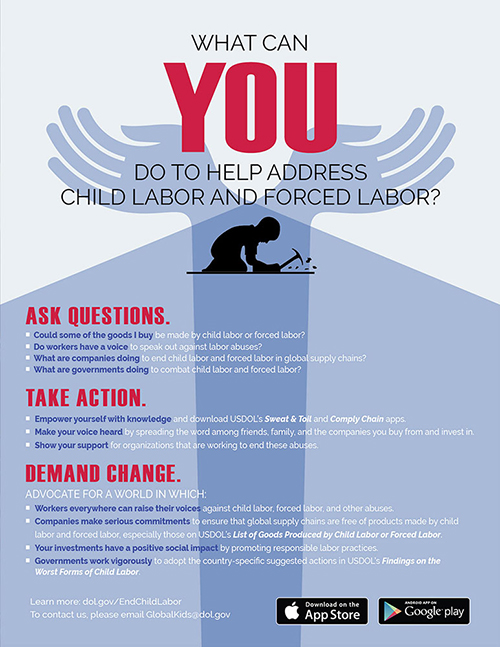List of Goods Produced by Child Labor or Forced Labor
The Bureau of International Labor Affairs (ILAB) maintains a list of goods and their source countries which it has reason to believe are produced by child labor or forced labor in violation of international standards, as required under the Trafficking Victims Protection Reauthorization Act (TVPRA) of 2005 and subsequent reauthorizations. The List of Goods Produced by Child Labor or Forced Labor comprises 159 goods from 78 countries and areas, as of September 28, 2022.
ILAB maintains the List primarily to raise public awareness about forced labor and child labor around the world and to promote efforts to combat them; it is not intended to be punitive, but rather to serve as a catalyst for more strategic and focused coordination and collaboration among those working to address these problems.
Publication of the List has resulted in new opportunities for ILAB to engage with foreign governments to combat forced labor and child labor. It is also a valuable resource for researchers, advocacy organizations and companies wishing to carry out risk assessments and engage in due diligence on labor rights in their supply chains.
The countries on the List span every region of the world. The most common agricultural goods listed are sugarcane, cotton, coffee, tobacco, cattle, rice, and fish. In the manufacturing sector, bricks, garments, textiles, footwear, carpets, and fireworks appear most frequently. In mined or quarried goods, gold, coal and diamonds are most common.
ILAB published the initial TVPRA List in 2009 and updated it annually through 2014, following a set of procedural guidelines that were the product of an intensive public consultation process. ILAB now updates and publishes the List every other year, pursuant to changes in the law.
Procedural Guidelines
On January 25, 2024, ILAB's Office of Child Labor, Forced Labor, and Human Trafficking published Procedural Guidelines for the development and maintenance of the List of Goods from countries produced by child labor or forced labor in violation of international standards.
| Country/Area | Good Sort ascending | Exploitation Type |
|---|---|---|
| Dominican Republic | There are reports that adults are forced to work in the harvesting and production of sugarcane in the Dominican Republic. These adults, the majority of whom are undocumented or stateless, are predominantly of Haitian origin or descent. Reports from civil society organizations, news media, worker interviews, field research, and other sources indicate the existence of the following forced labor indicators in the sugarcane sector: withholding of wages, abusive working and living conditions, excessive overtime, isolation and restriction of movement, and deceptive recruitment practices. For some workers, a precarious legal status and lack of identity documents limit their movement and have led to isolation and fears of reprisal, denouncement to authorities, loss of company-provided housing and deportation for complaining about unlawful labor conditions. In addition, illiteracy, low levels of education, and language barriers can impede their understanding and exercising of labor rights, thus increasing their vulnerability to labor exploitation. |
Child Labor, Forced Labor |
| El Salvador | Child Labor | |
| Guatemala | Child Labor | |
| India | Child Labor | |
| Kenya | Child Labor | |
| Mexico | Child Labor | |
| Pakistan | Forced Labor | |
| Paraguay | Child Labor | |
| Philippines | Child Labor | |
| Thailand | Child Labor |
your hand? Download ILAB's Sweat & Toil App today!
Are you a company looking to fight child labor and forced labor in supply
chains?





